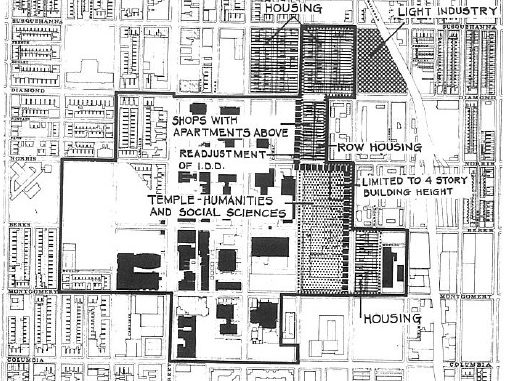
James Kelch sat in a community building in the Norris Homes housing project on 12th Street near Berks in 1969 to discuss Temple’s relations with the community as the university sought to double its size.
Nearly half a century later, Kelch, a social administration professor emeritus, said he believes the university should begin to do the same today.
“The whole idea of a charrette—its time has come again,” Kelch said. “It would serve both Temple’s interests and the community’s interests to come together and try to work it out, instead of just going ahead and doing things and expecting the community to react.”
A charrette is a meeting in which all project stakeholders aim to resolve conflicts and find solutions.
An expansion plan called the 1970 Institutional Development Plan sought to double Temple’s space to 2,384,000 square feet of space, along with an increase in enrollment.
This expansion plan immediately received pushback from the black communities surrounding Temple.
In March 1969, a group of African-American students named Steering Committee for Black Students presented a list of demands to former President Paul Anderson. These demands included the creation of an Afro-Asian Institute (now the African American studies department), the admission of at least 200 black students aided financially and a five-year degree program and verbal and written assurance that Temple has no intention of expanding any more east or west of Broad Street unless approved by the black community.
The group also demanded that all new and existing facilities be accessible to the black community, including Paley Library and Geasey Field.
After these demands were presented, this group of students jump-started deliberations for a charrette agreement, an intensive architectural planning session and began a moratorium on Temple’s planned expansion, which was placed until the community and Temple reached an agreement.
From Dec. 1, 1969 to Feb. 6, 1970, community members, Temple administrators and faculty, students and state and local legislators met at Norris Homes housing project to discuss Temple’s plans to expand. In Larry B. Morrison’s journal “The Community-Temple Charrette” came in a community that was “termed ‘sub-standard’ and ‘blighted’” by state government in 1948 as a part of a project for urban renewal.
“What the charrette agreement did was to indicate to Temple and the rest of Philadelphia that a lot of folks still saw [community surrounding Temple] as their community,” said university historian James Hilty.
Kelch was one of nearly a dozen community members, Temple administrators, faculty members and public agency representatives that attended the charrette deliberations. In a roundtable discussion that met over two months, the different parties were able to discuss their concerns and agendas as Temple continued to expand.
“It was very challenging because [the community] asked every question imaginable, which was good because I don’t think the university, to their own satisfaction, had thought out a number of these things,” Kelch said. “It really laid out the table what was going to be done and how it would be done.”
The final Community-Temple Agreement of 1970—which was drafted on Feb. 6, 1970—required community consultation of Temple prior to schematic plans or zoning changes, and established a Committee for Continuing Dialogue made up of community and representatives of the university and public agencies.
The charrette agreement stated that the university, state or city would not acquire Norris Homes housing project for any other use than low-income housing. The moratorium on construction was also lifted at the singing of this agreement.
Hilty said the charrette agreement is not a legal document, but the practices of the Institutional Development District are. Before Temple can build, it must receive approval from City Council to alter Temple’s IDD.
The charrette was later signed by former Gov. Raymond Shafer and all other parties involved in it. Hilty said the charrette still stands today.
“In the case of the possible football stadium and changes that are going to be made, it’s presumed that all the interested parties will be given the chance to respond and be taken into consideration,” Hilty said. “Let’s hope that gets done.”
Gillian McGoldrick can be reached at gillian.mcgoldrick@temple.edu or on Twitter @gill_mcgoldrick.


Be the first to comment